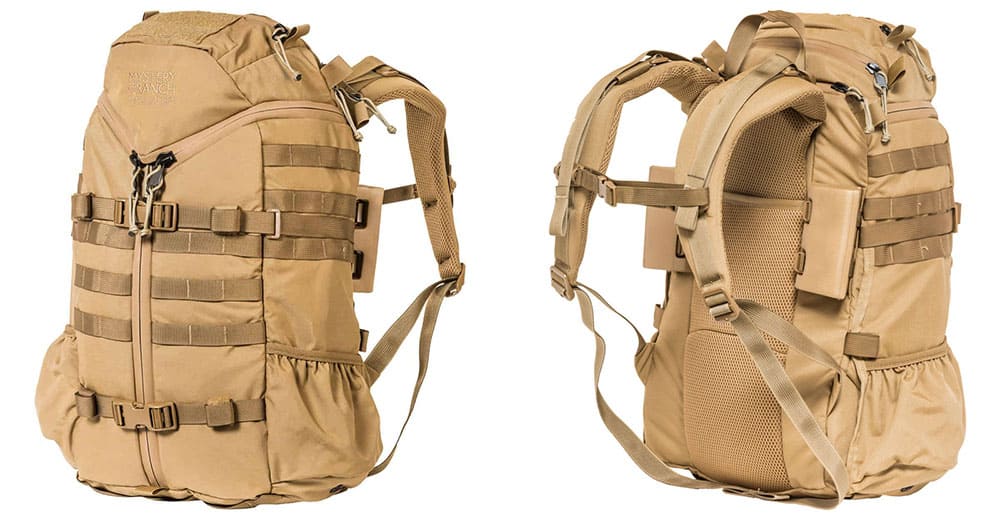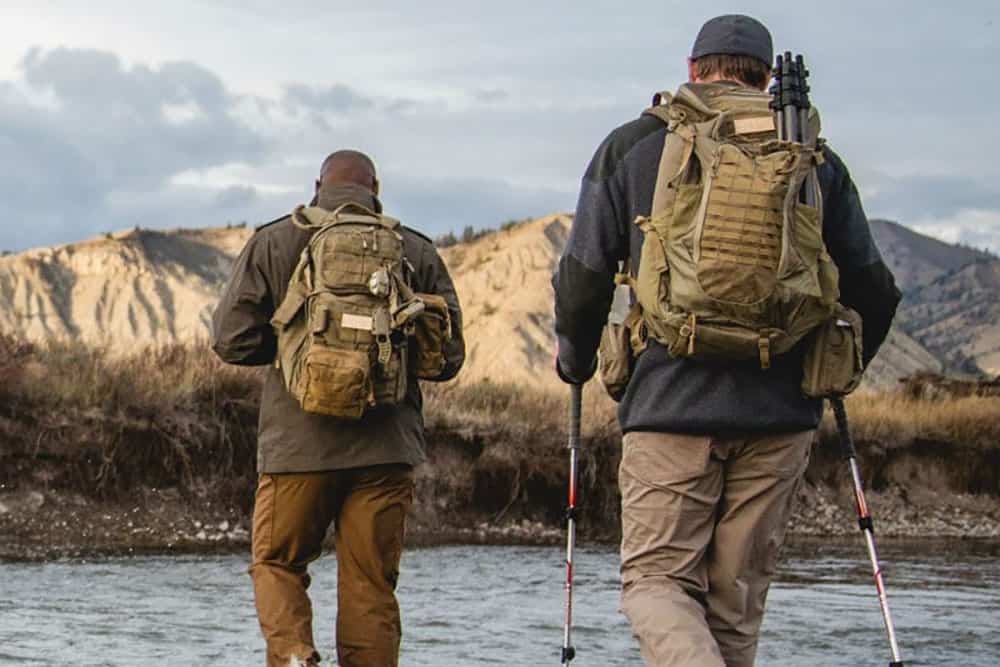A tactical backpack can be an invaluable asset, or it can make your day an insufferable, painful slog. If it does, however, it’s not the pack’s fault. A lot of thought goes into the design of the best tactical backpacks, but whether they live up to their promise depends in large part on whether the people packing them know what they’re doing.
Below we’re going to take a comprehensive look at the tactical backpack, how it’s built, what to put in it and, most of all, the right way to pack it.
What Makes a Backpack “Tactical”?
This is a common question, after all a pack is a pack is a pack, isn’t it? Well, not really. Yes, all backpacks are reinforced sacks that you put things in and sling over your shoulders. But the similarities between regular backpacks and tactical backpacks stop there.
True tactical backpacks are designed for military applications and make copious use of MOLLE technology (1). They’re extra rugged, modular and are fashioned using premium materials and hardware. They’re not intended to be worn on the runway. They’re designed to provide our men and women in uniform with the best chance of surviving a hostile environment.
So, what makes a backpack “tactical”? High quality materials throughout, MOLLE functionality, outstanding durability, and high degree of versatility. If the backpack you have your eye on does not provide those things then it’s not a true tactical backpack.
How Big is a Tactical Backpack?
The volume of a tactical backpack is denoted by liters and there are different sizes for different purposes. A tactical backpack used on a quick patrol of the area or for a photography day trip will usually range from 10 – 30 L. One the other hand if you intend to go hunting for several days or you are on an extended patrol in Somalia your pack may be as much as 40 L and maybe as much as 60 L. Tactical backpacks of this size are often referred to as “assault packs”.
Tactical Backpack Components
Any good tactical backpack – like the outstanding Mystery Ranch 3 Day Assault Pack pictured below – offers the following features:
- Large main storage area.
- Outer pockets both zippered and unzippered.
- Copious MOLLE webbing.
- Water repellent shell.
- Reinforced grab-and-go handles.
- Compression straps to secure the load.
- Waterproof compartments for your tech.
- Internal compartment for you hydration bladder.
The various pockets and pouches are arranged in such a way that if they are properly utilized the pack will be balanced and easy to control. Exactly what you put into the pack, however, will depend on your particular mission. That said there are certain basics that should always be included, such as:
- A well-considered first aid kit.
- High protein snacks, energy bars etc.
- Multitool, compass & map, survival knife.
- Headlamp and batteries.
- Water.
- Personal hygiene items.
You may not plan to be out after the sun goes down but you never know, so a headlamp is a must. And you certainly don’t plan on getting lost but you never know, so a compass and a map are crucial. The rest are self-explanatory.
The other things that go in the pack will be mission dependent. But let’s assume you are heading out into the wilderness – hostile or otherwise – for several days. In that case you will want to make sure you have
- A sleeping bag
- Extra clothing
- Sufficient food
- Stove and fuel, or a way to start a fire
- Communication equipment
- Sidearm, rifle or other appropriate weaponry
- Tactical flashlight
- Shelter
You may also want to bring things like paracord, a water filter, night vision goggles, winter gloves and whatnot. It will depend on what you plan to do.
Packing Your Tactical Backpack
When packing your tactical backpack your two prime considerations are comfort and balance. Carrying 40 or 50 pounds around all day is never going to be a non-stop laugh riot. But it doesn’t have to be a soul-crushing slog either. What will make it an ordeal is if the load is unbalanced. This will not only bring strange and harmful forces to bear on your back, but it could put you in grave danger if the load shifts while you’re clinging to a ledge. With that in mind let’s get busy.
Heavy Stuff on the Bottom
The bottom of your pack is reserved for heavy items like extra clothes, your stove and fuel. If you’re carrying a groundsheet that should also go at the bottom. The very bottom. Keeping heavy stuff low ensures gravity is a stabilizing force, not a destabilizing force.
The Middle Portion
The middle portion of your pack is where you’ll put your food, water bladder (this should be in its own pouch close to your body to enhance stability), eating utensils and other items that you’re not going to need during the day while you’re on the move.
The Top Portion
The top is reserved for those items that don’t weigh a ton and that you may need during the day. That means your rain poncho, extra socks, snacks, sunglasses, sunscreen and more.
Exterior Pockets and MOLLE Webbing
The exterior pockets and MOLLE webbing are reserved for those things you are likely to need at some point, or that you’ll need quick access to in case of emergency. That means your survival knife, compass and map, radio, flashlight, sunscreen, insect repellent and more in the pockets. And from the MOLLE webbing you can hang your first aid kit, drinking cup, tactical flashlight, gloves or anything else you can think of.
Handle the packing well and your tactical backpack will be comfortable and provide convenient access to what you need when you need it.
What to Look for in a Tactical Backpack
High quality fabric – As a general rule of thumb we want to see tactical backpacks cut from high quality cloth such as 500 – 1000D Cordura (2). If the pack you have your eye on uses polyester in the shell it’s not a good sign. Why Cordura? Because it’s stronger than No. 8 Duck (3) but only half the weight and exhibits outstanding resistance to abrasions, moisture-driven degradation and fading. It’s also highly water resistant.
High quality hardware – That light, strong Cordura won’t be worth much if the zippers and snaps on your pack fall apart after a couple of outings. For that reason we want to see hardware that’s the equal of the fabric. That means YKK Zippers or something equivalent (Riri, Talon, or IDEAL for instance) along with big, strong clips.
A variety of pockets, sleeves and compartments – We want to see a variety of options for holding different types of gear including zippered pockets, mesh sleeves, a waterproof pocket or pockets for protecting tech, a sleeve to hold a hydration bladder and more. There should be pockets and sleeves inside and out to provide as many storage options as possible.
MOLLE compatibility – As you saw in the video above MOLLE stands for “Modular Lightweight Load-carrying Equipment” and it is intended to provide an easy way for you to attach objects to the outside of your tactical backpack in whatever configuration works best for you. You can attach gear as is, or attach pouches that hold various items. MOLLE is a standard that transcends brands and is typically recognized by packs that have a PALS or “Pouch Attachment Ladder System” (4) Velcro grid (or 2 or 3) on the exterior.
Comfort – A great tactical backpack should slip over your shoulders and feel like an extension of your body. It should never dig into your shoulders or force your back into uncomfortable or unnatural positions. There should be room for air to circulate between your back and the pack so that you don’t overheat. And the padding that rests against your back should be firm but not hard.
Modularity/Ease of Access – A tactical backpack is all about making it easy for you to get hold of the things you need at any given moment. That’s part of the whole MOLLE modularity/pouches thing. You should be able to arrange your gear so that you can get a hold of your knife or compass or sunscreen or map or anything else without having to take everything apart. If you need to get inside for something you should be able to do so easily. A Tri-Zip system, like you’ll see on the Mystery Ranch 3 Day Assault Pack, enables this kind of easy access.
Aesthetics – This should be the last thing you consider (if you bother to consider it at all), which is why we put it last on our list of considerations. If you need a tactical backpack chances are good you are not engaged in the kind of activities where looking good is a prerequisite. Instead, you’re chasing bad guys through the Hindu Kush or on patrol in northeast Syria.
There are, however, plenty of civilians – including hunters, photographers and others – who find the tactical backpack to be right up their alley. They too, however, are not known to be fashion hounds. The bottom line is that it’s great if your pack has a snazzy profile, but it’s more important that it be tough, convenient and comfortable.






